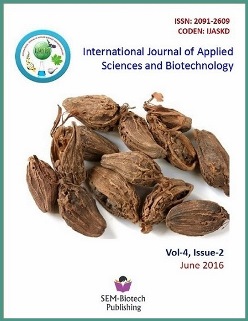Challenges and Opportunity of in vitro Propagation of Paulownia tomentosa Steud for Commercial Production in Nepal
DOI:
https://doi.org/10.3126/ijasbt.v4i2.14752Keywords:
Paulownia tomentosa, in vitro propagation, plant hormonesAbstract
Paulownia tomentosa Steud is a fast growing multipurpose tree. In vitro propagation using nodal explants of Paulownia tomentosa was performed by manipulating amount of cytokinin and auxin in culture media. Shoot bud proliferation from explants were assessed in Murashige and Skoog (MS) medium supplemented with various amounts of hormones such as a) 0.5-2.5 mg/l benzylaminopurine (BAP) and 0.1 mg/l naphthalene acetic acid (NAA), b) 0.5-2.5 mg/l BAP and 0.5-2.5 mg/l kinetin (KN) and c) 0.5- 2.5 mg/l BAP and 0.1 mg/l indole-3-acetic acid (IAA). In the present study, we found that hormone combination of BAP and NAA gave optimum growth results. MS medium enriched with 2.0 mg/l BAP and 0.1 mg/l IAA resulted a similar outcome but took 3-4 weeks with respect to the same medium enriched with 1.0 mg/ml BAP and 0.1 mg/ml NAA, which showed response within 2-3 weeks. Shoot length of 2.5-3.5 cm with 3-4 nodes and 8-12 leaves were obtained on MS medium supplemented with 1.0 mg/l BAP and 0.1 mg/l NAA. The acclimatization of explants was done in a polyhouse at 20±5oC for 2-6 weeks. Rooting has been induced in nonsterile sand. Rooted plants were transferred to plastic bags containing mixture of soil, sand and compost in the ratio of 1:1:1.
Besides aforementioned issues, there are several other challenges associated with in vitro propagation of P. tomentosa. The plants were established (90%) on MS medium enriched with BAP and NAA and adapted ex vitro with surviving up to 80%. People received an opportunity with this plant because it grows fast and can generate income in 10 years in comparison with others, but at the same time people also have been facing the challenges for plantation of P. tomentosa as government of Nepal does not formulate necessary national policies, legislations and regulatory frameworks in its favor. Thus, system should be developed to set royalty rate of P. tomentosa recognizing its lifetime value.
Int J Appl Sci Biotechnol, Vol 4(2): 155-160



